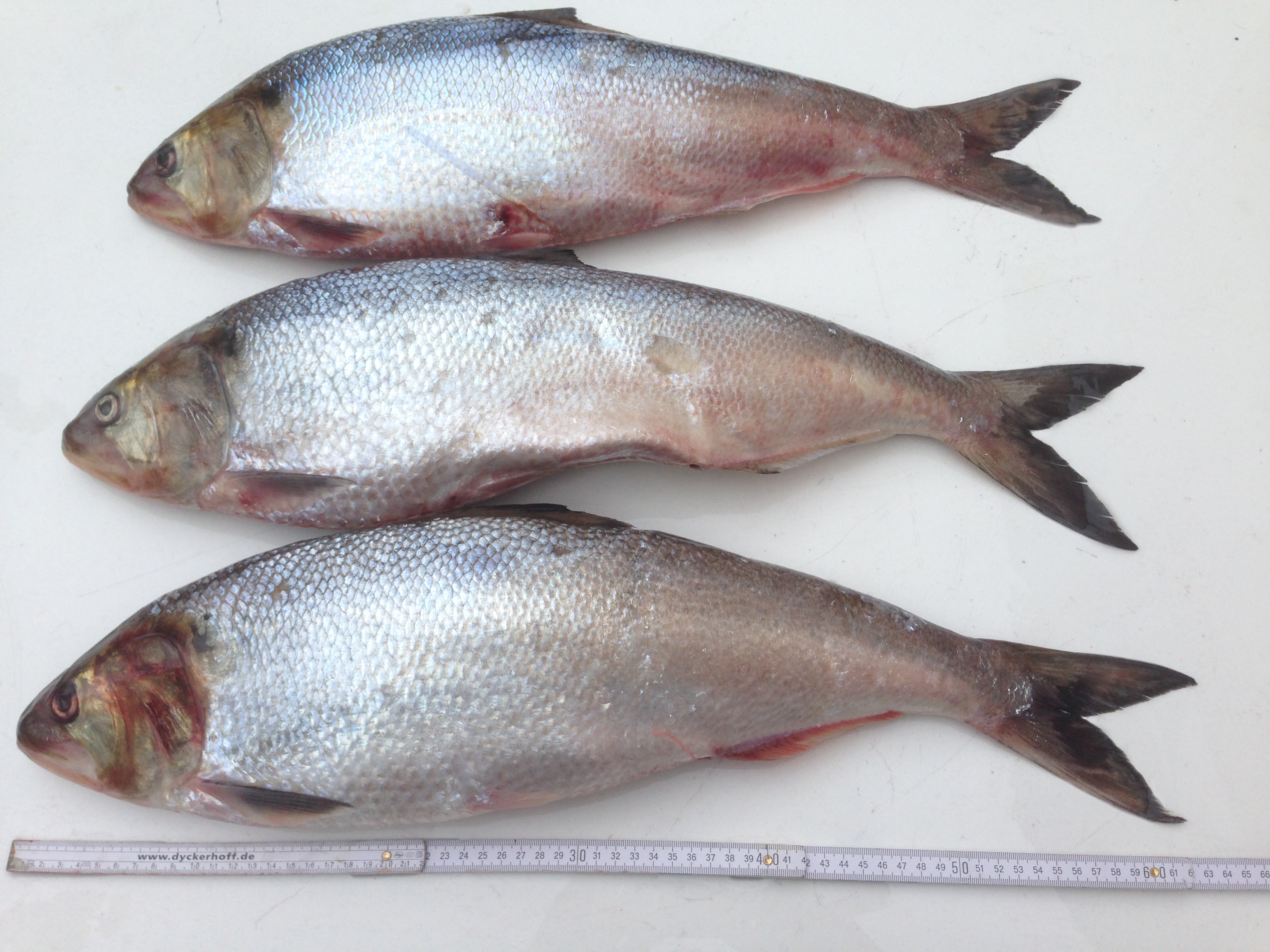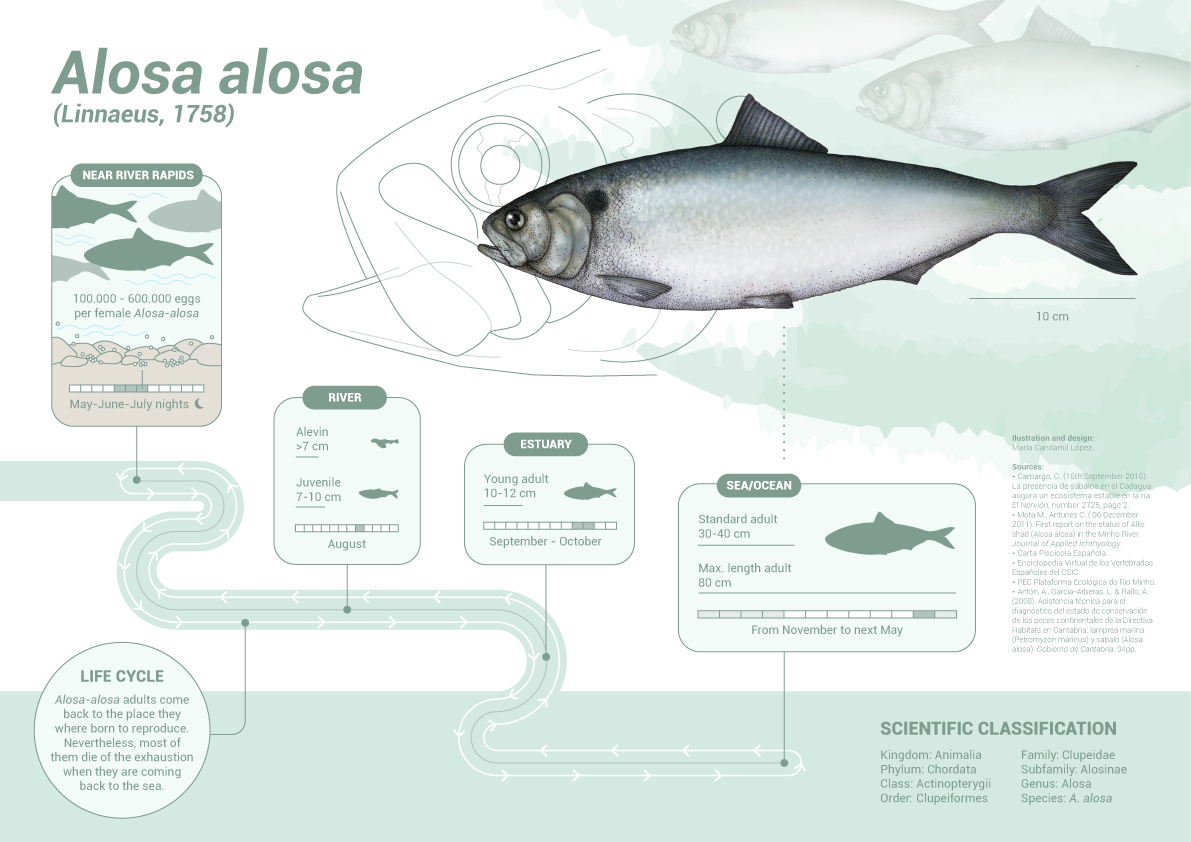Allis Shad on:
[Wikipedia]
[Google]
[Amazon]
 The allis shad (''Alosa alosa'') is a widespread Northeast Atlantic species of
The allis shad (''Alosa alosa'') is a widespread Northeast Atlantic species of
 ''Alosa alosa'' has a similar lifecycle to that of the
''Alosa alosa'' has a similar lifecycle to that of the
EU LIFE-Project: The re-introduction of allis shad (''Alosa alosa'') in the Rhine system
* {{Authority control Alosa Fauna of France Marine fish of Europe Fish described in 1758 Taxa named by Carl Linnaeus Least concern biota of Europe Taxonomy articles created by Polbot Habitats Directive species
fish
A fish (: fish or fishes) is an aquatic animal, aquatic, Anamniotes, anamniotic, gill-bearing vertebrate animal with swimming fish fin, fins and craniate, a hard skull, but lacking limb (anatomy), limbs with digit (anatomy), digits. Fish can ...
in the Alosidae family. It is an anadromous
Fish migration is mass relocation by fish from one area or body of water to another. Many types of fish migrate on a regular basis, on time scales ranging from daily to annually or longer, and over distances ranging from a few metres to thousa ...
fish which migrates into fresh water to spawn. It is found in the eastern Atlantic Ocean, the western Baltic Sea and the western Mediterranean Sea. In appearance it resembles an Atlantic herring
Atlantic herring (''Clupea harengus'') is a herring in the family Clupeidae. It is one of the most abundant fish species in the world. Atlantic herrings can be found on both sides of the northern Atlantic Ocean, congregating in large schools. ...
but has a distinctive dark spot behind the gill cover and sometimes a row of up to six spots behind this. It sometimes hybrid
Hybrid may refer to:
Science
* Hybrid (biology), an offspring resulting from cross-breeding
** Hybrid grape, grape varieties produced by cross-breeding two ''Vitis'' species
** Hybridity, the property of a hybrid plant which is a union of two diff ...
ises with the twait shad
The twait shad or twaite shad (''Alosa fallax'') is a species of fish in the family Alosidae. It is found in the eastern Atlantic Ocean and the Mediterranean Sea and is an Fish migration, anadromous fish which lives in the sea but migrates into f ...
(''A. fallax''). This fish becomes mature when three or more years old and migrates to estuaries, later swimming up rivers to spawn. Populations of this fish have declined due to overfishing
Overfishing is the removal of a species of fish (i.e. fishing) from a body of water at a rate greater than that the species can replenish its population naturally (i.e. the overexploitation of the fishery's existing Fish stocks, fish stock), resu ...
, pollution and habitat destruction
Habitat destruction (also termed habitat loss or habitat reduction) occurs when a natural habitat is no longer able to support its native species. The organisms once living there have either moved elsewhere, or are dead, leading to a decrease ...
. Conservation of this species is covered by Appendix III of the Bern Convention and Appendix II and V of the European Community Habitats Directive
The Habitats Directive (more formally known as Council Directive 92/43/EEC on the Conservation of natural habitats and of wild fauna and flora) is a directive adopted by the European Community in 1992 as a response to the Berne Convention. The ...
.
Description
The allis shad is a typical herring-type fish. It has nolateral line
The lateral line, also called the lateral line organ (LLO), is a system of sensory organs found in fish, used to detect movement, vibration, and pressure gradients in the surrounding water. The sensory ability is achieved via modified epithelia ...
and a somewhat rounded belly. The gill cover
The operculum is a series of bones found in bony fish and Chimaera, chimaeras that serves as a facial support structure and a protective covering for the gills; it is also used for respiration and feeding.
Anatomy
The opercular series contain ...
is ridged and the scales
Scale or scales may refer to:
Mathematics
* Scale (descriptive set theory), an object defined on a set of points
* Scale (ratio), the ratio of a linear dimension of a model to the corresponding dimension of the original
* Scale factor, a number ...
large. The back is a bluish-green colour and the head brownish with a golden tinge on the operculum. The flanks are silvery, sometimes with a bronzy tinge, and a distinctive large dark spot occurs just behind the gill cover, and occasionally one to six smaller spots behind that. The adult length is typically .
Distribution
The allis shad is found in the eastern Atlantic in waters bordering most ofEurope
Europe is a continent located entirely in the Northern Hemisphere and mostly in the Eastern Hemisphere. It is bordered by the Arctic Ocean to the north, the Atlantic Ocean to the west, the Mediterranean Sea to the south, and Asia to the east ...
and northwestern Africa
Africa is the world's second-largest and second-most populous continent after Asia. At about 30.3 million km2 (11.7 million square miles) including adjacent islands, it covers 20% of Earth's land area and 6% of its total surfac ...
, and it enters to the western Baltic
Baltic may refer to:
Peoples and languages
*Baltic languages, a subfamily of Indo-European languages, including Lithuanian, Latvian and extinct Old Prussian
*Balts (or Baltic peoples), ethnic groups speaking the Baltic languages and/or originatin ...
and western Mediterranean
The Mediterranean Sea ( ) is a sea connected to the Atlantic Ocean, surrounded by the Mediterranean basin and almost completely enclosed by land: on the east by the Levant in West Asia, on the north by Anatolia in West Asia and Southern ...
Seas, but it is rare outside and increasingly within France
France, officially the French Republic, is a country located primarily in Western Europe. Overseas France, Its overseas regions and territories include French Guiana in South America, Saint Pierre and Miquelon in the Atlantic Ocean#North Atlan ...
. There are no longer breeding populations in Morocco or Mediterranean Spain.
Biology and lifecycle
 ''Alosa alosa'' has a similar lifecycle to that of the
''Alosa alosa'' has a similar lifecycle to that of the twait shad
The twait shad or twaite shad (''Alosa fallax'') is a species of fish in the family Alosidae. It is found in the eastern Atlantic Ocean and the Mediterranean Sea and is an Fish migration, anadromous fish which lives in the sea but migrates into f ...
''A. fallax''. They are known to live in sympatry
In biology, two closely related species or populations are considered sympatric when they exist in the same geographic area and thus frequently encounter each other. An initially interbreeding population that splits into two or more distinct spe ...
,Lochet, A., S. Boutry, and E. Rochard. ''Estuarine Phase during Seaward Migration for Allis Shad Alosa Alosa and Twaite Shad Alosa Fallax Future Spawners.'' Ecology of Freshwater Fish 18 (2009): 323–35. and the two species can hybridize. They are anadromous
Fish migration is mass relocation by fish from one area or body of water to another. Many types of fish migrate on a regular basis, on time scales ranging from daily to annually or longer, and over distances ranging from a few metres to thousa ...
species like many other species in the genus ''Alosa''.Coscia, I., V. Rountree, J. J. King, W. K. Roche, and S. Mariani. ''A Highly Permeable Species Boundary between Two Anadromous Fishes.'' Journal of Fish Biology 77.5 (2010): 1137–149. However, some record of them being landlocked suggests an ability to adapt well to their environment.
They primarily live at sea on feeding grounds and migrate to their spawning grounds between April and June once they are sexually mature. Maturity usually ranges from 3–7 years of age. ''A. alosa'' can usually only reproduce once in their lifetimes. Juveniles appear in estuaries
An estuary is a partially enclosed coastal body of brackish water with one or more rivers or streams flowing into it, and with a free connection to the open sea. Estuaries form a transition zone between river environments and maritime environm ...
and brackish water around July to August. The salinity of brackish water may pose problems to the juveniles migrating from fresh water.
The estuarine phase, or the time spent in estuaries migrating from spawning grounds to sea, is estimated to have a duration in ''A. alosa'' of up to six months. The estimate, however, does not take into account individual variation and/or survival of juveniles in the estuarine phase.
Population reduction
Populations have been reduced primarily by overfishing, pollution, and habitat destruction.Siltation
Siltation is water pollution caused by particulate terrestrial clastic material, with a particle size dominated by silt or clay. It refers both to the increased concentration of suspended sediments and to the increased accumulation (temporary o ...
and gravel
Gravel () is a loose aggregation of rock fragments. Gravel occurs naturally on Earth as a result of sedimentation, sedimentary and erosion, erosive geological processes; it is also produced in large quantities commercially as crushed stone.
Gr ...
mining threaten spawning locations. There is concern that barriers to migration like dams are causing allis shad to spawn downstream from their usual locations, potentially prompting hybridization with twaite shad. Climate change may force the species' distribution to shift or contract further. The International Union for Conservation of Nature
The International Union for Conservation of Nature (IUCN) is an international organization working in the field of nature conservation and sustainable use of natural resources. Founded in 1948, IUCN has become the global authority on the stat ...
listed the species as critically endangered
An IUCN Red List critically endangered (CR or sometimes CE) species is one that has been categorized by the International Union for Conservation of Nature as facing an extremely high risk of extinction in the wild. As of December 2023, of t ...
in 2024, citing an estimated global population decline of around 80% over the past 20 years, leaving many small relict subpopulations and extirpating
Local extinction, also extirpation, is the termination of a species (or other taxon) in a chosen geographic area of study, though it still exists elsewhere. Local extinctions are contrasted with global extinctions.
Local extinctions mark a chan ...
others.
Conservation
Four special areas of conservation have been designated in Ireland where ''Alosa'' species have been known to spawn. ''Alosa alosa'' "has been placed in Appendix III of the Bern Convention (1979) that lists protected fauna species as well as in Appendix II and V of the European Community Habitats Directive (1992) that list, respectively, species whose conservation requires the designation of special areas of conservation and that are subject to management measures." However, ''A. alosa'' is currently under a moratorium (2008) in numerous French watersheds.References
External links
EU LIFE-Project: The re-introduction of allis shad (''Alosa alosa'') in the Rhine system
* {{Authority control Alosa Fauna of France Marine fish of Europe Fish described in 1758 Taxa named by Carl Linnaeus Least concern biota of Europe Taxonomy articles created by Polbot Habitats Directive species